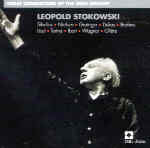A case can be made that everything Stokowski conducts on this wide-ranging 2-disc set in EMI’s Great Conductors of the 20th Century series was by his contemporaries. Even the oldest died when Stokowski was a toddler (Wagner) or a teenager (Brahms). Since many of us saw Stokowski conduct (he died in 1977) he thus provides a link, however tenuous, with the distant past. Such irrelevancies aside, this set is welcome not only for some stirring recordings but for its focus on the latter stages of Stokowski’s long career. The earliest item dates from 1950 (three brief Percy Grainger miniatures); the last, from 1976 (Sibelius’ First Symphony). There’s no hint (in the Sibelius) that the conductor was then pushing 95, for it’s a vigorous performance, full of orchestral detail and typically Stokowskian flourishes, such as the emphasis on lush strings and orchestral color. The general approach, as you’d expect, is Tchaikovskian, with swooping Slavic themes and a brooding Andante much slower than the norm–and not entirely to its benefit. But Stoky loved extremes, and when the Scherzo rolls around he sounds like a frisky youth again. The last movement has a compelling, driving force that sweeps you along. Recorded even later, just months before Stokowski died, is a fairly straight-forward, fast-paced Brahms Tragic Overture.
Nielsen’s Second Symphony “The Four Temperaments” is the only live performance in the set, taken from a 1967 Copenhagen concert with the Danish State Radio Symphony. It’s a very good reading: each of the movements, or “temperaments”, is neatly characterized with an orchestra that was hardly world-class but deeply immersed in Nielsen’s music. Aside from the symphonies, the longest track here is a 26-minute chunk of Wagner’s Liebesnacht and Liebestod from Tristan und Isolde, sounding strange indeed with instruments replacing voices in Stoky’s own syrupy arrangement. An oddity is a set of three brief trifles by Percy Grainger in his own arrangements for orchestra. He joins at the piano too, in what sounds like music lifted from the soundtrack of a film cartoon.
Stokowski was a premier colorist, so he’s in his element in the remaining items of the set. He draws deep bass hues as well as bright primary colors from Liszt’s Hungarian Rhapsody No. 1 and even brighter ones from Dukas’ opening Fanfare from La Péri. Turina’s La oración del torero is deeply atmospheric, and Escales is a delight, the French band’s idiomatic timbres helping Stokowski to wring all the subtle tints and shadings from Ibert’s unique orchestral pictures of Mediterranean cities. A rollicking Russian Sailor’s Dance from Glière’s Red Poppy ballet brings the set to a rousing conclusion. In sum, a set worth hearing and a must for Stokowski fans. [4/29/2003]
































